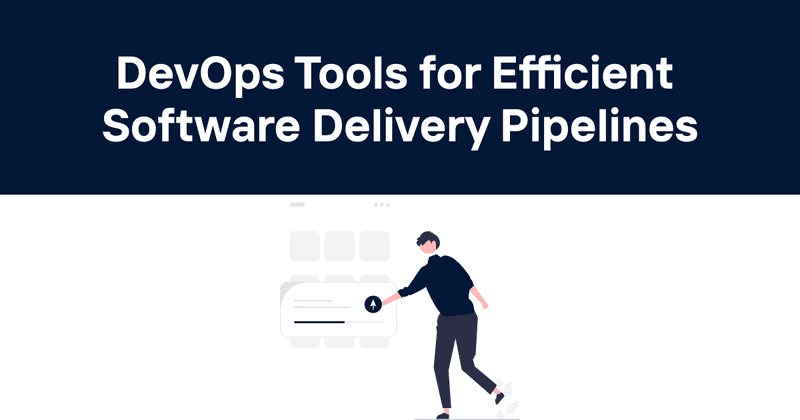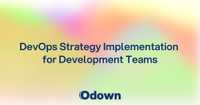DevOps Tools for Efficient Software Delivery Pipelines
DevOps isn't just a trendy buzzword. It's a game-changing methodology that has transformed how organizations build, deploy, and maintain software. But DevOps is only as effective as the tools that power it.
I've spent years implementing DevOps practices across organizations of various sizes, and I've learned that selecting the right tools can make or break your DevOps transformation. Let's explore the essential DevOps tools that can help you streamline your software delivery pipeline and improve collaboration between development and operations teams.
Table of contents
- Understanding DevOps and its importance
- Version control systems
- Containerization tools
- Infrastructure as code (IaC)
- Configuration management tools
- CI/CD platforms
- Container orchestration
- Monitoring and observability
- Log management
- Security tools
- Collaborative infrastructure delivery
- Service mesh technologies
- Secret management solutions
- Uptime monitoring with Odown
Understanding DevOps and its importance
DevOps represents a cultural shift that brings development and operations teams together to collaborate more effectively. It's about breaking down silos, automating processes, and creating a continuous feedback loop that leads to faster, more reliable software delivery.
The DevOps lifecycle typically involves several key phases:
- Discover and plan
- Build and test
- Deploy
- Operate and monitor
- Collect feedback and iterate
Each phase requires specific tools to automate and streamline workflows. The right DevOps toolchain can help organizations ship better software faster, reduce time to market, and increase customer satisfaction.
There are two primary approaches to building a DevOps toolchain:
- All-in-one solution: A complete package that typically doesn't integrate with third-party tools
- Open toolchain: A customizable collection of best-of-breed tools tailored to an organization's unique needs
I personally prefer the open toolchain approach because it offers greater flexibility and allows teams to select the best tools for their specific requirements. However, this approach requires careful consideration to ensure that the chosen tools integrate well with each other.
Let's dive into the essential tools for each phase of the DevOps lifecycle.
Version control systems
Version control systems (VCS) are the foundation of any DevOps toolchain. They allow teams to track changes to code, collaborate effectively, and maintain a single source of truth for their codebase.
Git
Git has become the de facto standard for version control. Its distributed nature, powerful branching and merging capabilities, and extensive ecosystem make it an essential tool for DevOps teams.
What makes Git particularly valuable is its ability to support various workflow models, such as:
- Feature branching
- Trunk-based development
- Gitflow
Git's flexibility allows teams to adopt the workflow that best suits their needs and practices.
Code repository platforms
While Git provides the version control system, code repository platforms offer a collaborative environment for managing code repositories, code reviews, and pull requests.
Some popular code repository platforms include:
- GitHub: The most widely used platform with a vast ecosystem and excellent integration options
- GitLab: A complete DevSecOps platform with built-in CI/CD capabilities
- Bitbucket: Part of Atlassian's suite with native Jira integration
These platforms enhance collaboration through features like pull requests, which enable peer code reviews before changes are merged into the main codebase. This practice improves code quality and reduces the likelihood of bugs making their way into production.
Containerization tools
Containerization has revolutionized application deployment by packaging applications and their dependencies into lightweight, portable containers. This approach ensures consistency across different environments and simplifies the deployment process.
Docker
Docker pioneered the containerization revolution and remains the most popular containerization tool. It provides a simple and efficient way to create, deploy, and run containers.
What I love about Docker is its simplicity. The Dockerfile syntax is intuitive, making it easy to define and build container images. Docker's vast ecosystem also includes Docker Hub, a repository for sharing and distributing container images.
For example, a basic Dockerfile might look like this:
WORKDIR /app
COPY package*.json ./
RUN npm install
COPY . .
EXPOSE 3000
CMD [ "npm", "start" ]
This simple file defines everything needed to containerize a Node.js application.
Other containerization tools
While Docker dominates the containerization landscape, other tools are gaining traction:
- Kaniko: A tool for building container images from a Dockerfile inside a Kubernetes cluster without requiring privileged access
- Podman: A daemonless container engine for developing, managing, and running OCI containers
These alternatives offer unique features that may better suit specific use cases or organizational requirements.
Infrastructure as code (IaC)
Infrastructure as Code (IaC) allows teams to manage and provision infrastructure through code rather than manual processes. This approach brings version control, testing, and automation to infrastructure management.
Terraform
Terraform has emerged as the leading IaC tool, offering a cloud-agnostic solution for provisioning infrastructure. Its declarative approach allows users to define the desired state of their infrastructure, and Terraform handles the rest.
I've used Terraform extensively, and its state management capabilities are particularly impressive. Terraform tracks the current state of your infrastructure, allowing it to plan and apply changes intelligently.
A simple Terraform configuration might look like this:
region = "us-west-2"
}
resource "aws_instance" "example" {
ami = "ami-0c55b159cbfafe1f0"
instance_type = "t2.micro"
tags = {
Name = "example-instance"
}
}
OpenTofu
OpenTofu is an open-source fork of Terraform that emerged after HashiCorp changed Terraform's license. It aims to maintain compatibility with Terraform while building new features and improvements.
For teams concerned about HashiCorp's licensing changes, OpenTofu offers a viable alternative that preserves the familiar Terraform workflow.
Cloud-specific IaC tools
Each major cloud provider offers its own IaC solution:
- AWS CloudFormation: AWS's native IaC service that uses JSON or YAML templates
- AWS CDK: Allows defining AWS infrastructure using programming languages
- Azure Resource Manager (ARM) Templates: Azure's JSON-based IaC solution
- Azure Bicep: A domain-specific language for deploying Azure resources
These cloud-specific tools often provide deeper integration with their respective platforms but lack the cross-cloud flexibility of Terraform.
Configuration management tools
Configuration management tools automate the provisioning and management of software, ensuring consistency across environments and reducing manual configuration tasks.
Ansible
Ansible has gained popularity due to its simplicity and agentless architecture. It uses SSH connections to configure remote systems, eliminating the need for additional software on managed nodes.
I appreciate Ansible's straightforward YAML-based playbooks and its idempotent nature, which means running the same playbook multiple times produces consistent results.
Here's an example of a simple Ansible playbook:
- name: Install and configure web server
hosts: webservers
become: true
tasks:
- name: Install nginx
apt:
name: nginx
state: present
- name: Start nginx service
service:
name: nginx
state: started
enabled: true
Chef, Puppet, and Salt
Other popular configuration management tools include:
- Chef: Uses a Ruby-based DSL and a client-server architecture
- Puppet: Offers a declarative approach to configuration management
- Salt: Provides high-speed communication for efficient configuration management at scale
Each of these tools has its strengths and weaknesses, and the best choice depends on specific requirements and existing infrastructure.
CI/CD platforms
Continuous Integration and Continuous Delivery (CI/CD) platforms automate the building, testing, and deployment of applications, enabling faster and more reliable releases.
Jenkins
Jenkins is a popular open-source automation server that supports building, deploying, and automating projects. Its extensive plugin ecosystem allows integration with virtually any tool in the DevOps landscape.
While Jenkins has been a staple in CI/CD for years, its setup and maintenance can be complex. That said, it offers unparalleled flexibility for organizations with specific requirements.
Cloud-based CI/CD services
Cloud-based CI/CD services have gained popularity due to their ease of use and reduced maintenance overhead:
- GitHub Actions: Integrated directly into GitHub repositories
- GitLab CI/CD: Part of GitLab's DevSecOps platform
- CircleCI: A cloud-native CI/CD platform with a focus on speed and efficiency
These services offer simpler setup and maintenance while providing powerful automation capabilities. GitHub Actions, in particular, has seen rapid adoption due to its tight integration with GitHub repositories.
A simple GitHub Actions workflow might look like this:
on:
push:
branches: [ main ]
pull_request:
branches: [ main ]
jobs:
build:
runs-on: ubuntu-latest
steps:
- uses: actions/checkout@v2
- name: Set up Node.js
uses: actions/setup-node@v1
with:
node-version: '14'
- name: Install dependencies
run: npm ci
- name: Run tests
run: npm test
Container orchestration
Container orchestration tools automate the deployment, scaling, and management of containerized applications, enabling organizations to run applications reliably at scale.
Kubernetes
Kubernetes has become the de facto standard for container orchestration. It provides a robust platform for automating deployment, scaling, and operations of application containers across clusters of hosts.
I've worked with Kubernetes extensively, and while it has a steep learning curve, its powerful features justify the investment. Kubernetes offers self-healing capabilities, automatic scaling, and service discovery, making it ideal for managing complex microservices architectures.
Here's a simple Kubernetes deployment definition:
kind: Deployment
metadata:
name: nginx
spec:
replicas: 3
selector:
matchLabels:
app: nginx
template:
metadata:
labels:
app: nginx
spec:
containers:
- name: nginx
image: nginx:1.19
ports:
- containerPort: 80
Managed Kubernetes services
Most cloud providers offer managed Kubernetes services that simplify cluster management:
- Amazon EKS: Amazon Elastic Kubernetes Service
- Google GKE: Google Kubernetes Engine
- Microsoft AKS: Azure Kubernetes Service
These services handle the Kubernetes control plane management, reducing operational overhead.
Simpler alternatives
For organizations not ready for Kubernetes, simpler alternatives include:
- Amazon ECS: A fully managed container orchestration service
- AWS Fargate: A serverless compute engine for containers
- Azure Container Apps: A fully managed serverless container service
These options offer easier management but with fewer customization options compared to Kubernetes.
Monitoring and observability
Monitoring and observability tools provide insights into application and infrastructure performance, helping teams identify and resolve issues quickly.
Prometheus
Prometheus has emerged as a popular open-source monitoring system with a dimensional data model and a flexible query language. It's particularly well-suited for monitoring Kubernetes environments.
I've found Prometheus's pull-based architecture and support for multi-dimensional data to be particularly valuable for monitoring modern, dynamic infrastructures.
Grafana
Grafana is often paired with Prometheus to provide visualization capabilities. It supports multiple data sources and offers a user-friendly interface for creating dashboards.
What makes Grafana special is its ability to create comprehensive dashboards that combine data from multiple sources, providing a unified view of your infrastructure and applications.
Commercial observability platforms
Commercial observability platforms offer more comprehensive solutions with easier setup:
- Datadog: Provides monitoring, analytics, and visualization across your entire stack
- New Relic: Offers a unified platform for application and infrastructure monitoring
- Dynatrace: Uses AI to provide automated monitoring and problem detection
These platforms often include additional features like log management, application performance monitoring (APM), and synthetic monitoring.
Log management
Log management tools collect, process, and analyze log data from applications and infrastructure, helping teams troubleshoot issues and gain insights.
ELK Stack
The ELK Stack (Elasticsearch, Logstash, and Kibana) is a popular open-source log management solution:
- Elasticsearch: A distributed search and analytics engine
- Logstash: A data processing pipeline
- Kibana: A visualization and exploration tool
The ELK Stack provides powerful log analysis capabilities and is highly customizable, but it can be complex to set up and maintain.
Cloud-based log management
Cloud-based log management solutions offer simpler setup and maintenance:
- AWS CloudWatch Logs: Integrated with AWS services
- Google Cloud Logging: Part of Google Cloud's operations suite
- Azure Monitor Logs: Provides log analytics for Azure environments
These services integrate well with their respective cloud platforms and offer simpler setup compared to self-hosted solutions.
Modern alternatives
Modern log management tools focus on simplicity and performance:
- Grafana Loki: A horizontally scalable, multi-tenant log aggregation system
- Fluentd: An open-source data collector for unified logging
These tools offer simpler architectures while still providing powerful log management capabilities.
Security tools
DevSecOps integrates security into the DevOps lifecycle, and specialized tools help identify and address security issues early in the development process.
Vulnerability scanning
Vulnerability scanning tools identify security issues in code, dependencies, and container images:
- Snyk: Finds and fixes vulnerabilities in open-source dependencies
- Trivy: A simple, comprehensive vulnerability scanner for containers
- OWASP Dependency-Check: Identifies known vulnerabilities in project dependencies
Regular vulnerability scanning helps teams address security issues before they reach production.
Compliance and policy enforcement
Compliance and policy enforcement tools ensure that infrastructure and applications meet security standards:
- Open Policy Agent (OPA): A policy engine that enforces policies across the stack
- Checkov: Scans cloud infrastructure configurations to find misconfigurations
- Terrascan: Detects compliance and security violations across Infrastructure as Code
These tools help organizations maintain security standards across their infrastructure and applications.
Collaborative infrastructure delivery
Collaborative infrastructure delivery tools enable teams to work together on infrastructure changes, providing visibility and control over the process.
Spacelift
Spacelift focuses on flexibility and user experience, supporting multiple infrastructure tools like Terraform, CloudFormation, and Pulumi. It offers features like self-hosted workers, workflow customization, and drift detection.
Terraform Cloud
Terraform Cloud is HashiCorp's SaaS offering for Terraform workflow management. It provides remote state management, plan and apply workflows, and policy enforcement.
Atlantis
Atlantis is an open-source, self-hosted Terraform pull request automation tool. It integrates with version control systems to automate Terraform workflow through pull request comments.
These tools facilitate collaboration on infrastructure changes, reducing the risk of errors and improving governance.
Service mesh technologies
Service mesh technologies provide a dedicated infrastructure layer for handling service-to-service communication, offering features like traffic management, security, and observability.
Istio
Istio is one of the most popular service mesh solutions, providing a comprehensive feature set for managing microservices. It offers traffic management, security features, and detailed telemetry.
Linkerd
Linkerd is a lightweight service mesh focused on simplicity and performance. It provides similar features to Istio but with a smaller footprint and easier configuration.
Consul
HashiCorp Consul offers service mesh capabilities along with service discovery and configuration management. It integrates well with other HashiCorp products like Terraform and Vault.
Service mesh technologies are particularly valuable for organizations with complex microservices architectures, providing consistent management of service-to-service communication.
Secret management solutions
Secret management solutions securely store and manage sensitive information like API keys, passwords, and certificates.
HashiCorp Vault
HashiCorp Vault is a comprehensive secret management solution that provides secure storage, dynamic secrets, and identity-based access.
I've used Vault in several projects, and its dynamic secret generation capabilities are particularly valuable. Vault can generate short-lived credentials for databases, cloud providers, and other systems, reducing the risk of credential exposure.
Cloud-based secret management
Cloud providers offer their own secret management solutions:
- AWS Secrets Manager: Manages secrets for AWS services and applications
- Google Secret Manager: Stores API keys, passwords, certificates, and other sensitive data
- Azure Key Vault: Safeguards cryptographic keys and secrets
These services integrate well with their respective cloud platforms and often provide simpler setup compared to self-hosted solutions.
Uptime monitoring with Odown
Monitoring the availability and performance of your applications is crucial for maintaining a reliable service. Odown provides comprehensive uptime monitoring for websites and APIs, ensuring that issues are detected and addressed promptly.
Website and API monitoring
Odown offers reliable monitoring for both websites and APIs, checking their availability at regular intervals from multiple locations around the world. This approach ensures that you get notified of outages quickly, regardless of where your users are located.
The monitoring system checks not only if your service is up but also verifies that it's functioning correctly. For APIs, this means validating responses against expected formats and values.
SSL certificate monitoring
SSL certificates are essential for securing web traffic, but they can cause major outages if they expire unexpectedly. Odown's SSL certificate monitoring keeps track of your certificates and alerts you well before they expire, giving you ample time to renew them.
The system checks:
- Certificate expiration dates
- Certificate validity
- SSL/TLS configuration
- Security vulnerabilities in your SSL setup
This proactive approach prevents the embarrassment and security risks associated with expired certificates.
Public status pages
Communication is key during outages. Odown's public status pages provide a transparent way to communicate the status of your services to users and stakeholders.
These customizable status pages:
- Display the current status of your services
- Show planned maintenance windows
- Provide incident history
- Automatically update when issues are detected
By maintaining transparent communication through status pages, you can build trust with your users even when things go wrong.
Integration with DevOps toolchains
Odown integrates seamlessly with your existing DevOps toolchain, allowing you to:
- Receive alerts in your preferred communication channels (Slack, email, etc.)
- Trigger automated remediation workflows when issues are detected
- Include uptime metrics in your dashboards and reports
These integrations ensure that Odown becomes an integral part of your overall monitoring and incident response strategy.
By implementing a robust uptime monitoring solution like Odown, you can detect and respond to issues quickly, minimizing downtime and providing a better experience for your users.
DevOps tools are essential for automating and streamlining the software delivery process. By selecting the right tools for each phase of the DevOps lifecycle, organizations can improve collaboration, reduce time to market, and deliver higher-quality software.
The tools discussed in this article represent some of the most popular and effective options available today, but the best choice depends on your specific requirements, existing infrastructure, and team expertise. What works for a large enterprise might not be suitable for a small startup, and vice versa.
Remember that DevOps is primarily about culture and practices, with tools serving as enablers. Focus on fostering collaboration between development and operations teams, automating repetitive tasks, and establishing a continuous feedback loop. The right tools will help you achieve these goals more effectively.
For monitoring the availability and performance of your applications, consider using Odown to ensure reliable uptime, secure SSL certificates, and transparent communication with users through public status pages.



